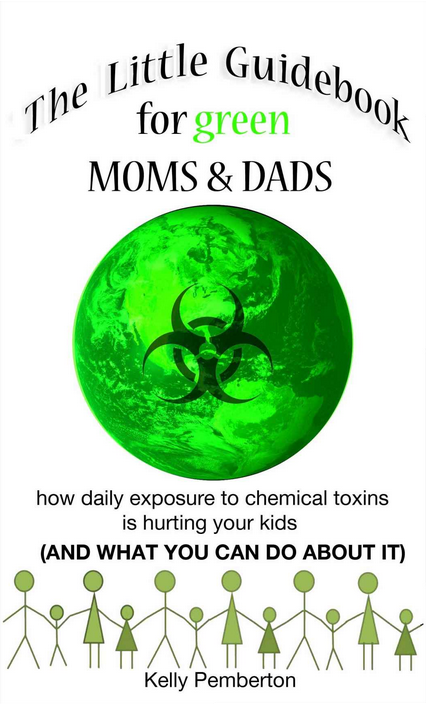Green and Prosperous began as a vehicle for getting the word out about how toxic chemicals are routinely used in the products we buy. The Little Guidebook for Green Moms and Dads is the first ebook in a series of “Green Guidebooks” published by Kelly Pemberton, the face behind Green and Prosperous. Although The Little Guidebook focuses on children’s products, it has something to offer for everyone. The second edition of this ebook is available for download on Amazon.com.
This post discusses how The Little Guidebook for Green Moms and Dads can help you educate yourself and minimize your family’s exposure to harmful toxins. As the book demonstrates, it’s important for all of us, as parents, consumers, and concerned citizens, to take a stand to minimize the risk from toxic chemicals to our health and the environment.
 Below, an excerpt from the second chapter of the book looks at some of the effects of the chemical “body burden” that all humans carry. The “body burden” refers to the total chemical load that is present in a person’s body at any given time. While exposure to a single toxic chemical may not have much of an effect on a person’s health, the alarming fact is that our bodies have many toxic chemicals in them at any given time. This is true even if you maintain a very healthy lifestyle, or if you live in a remote location, far from civilization.
Below, an excerpt from the second chapter of the book looks at some of the effects of the chemical “body burden” that all humans carry. The “body burden” refers to the total chemical load that is present in a person’s body at any given time. While exposure to a single toxic chemical may not have much of an effect on a person’s health, the alarming fact is that our bodies have many toxic chemicals in them at any given time. This is true even if you maintain a very healthy lifestyle, or if you live in a remote location, far from civilization.
What is most disturbing is how few of the 80,000 chemicals available on the U.S. market today have been tested for safety. Even those that are tested and deemed safe may later be found to cause harm, particularly to the developing bodies of fetuses and young children. This was the case with DDT years ago. More recently, it was the case with BPA, a chemical used in the manufacture of plastics.
Exposure to harmful chemicals does not have the same effects on everyone, but there is strong evidence to suggest links between the increase in our chemical “body burden” and the rise of disorders and diseases like cancer, infertility, miscarriage, birth defects, learning disabilities and extreme allergies, asthma, and ADD. The bodies of babies in utero through the toddler years (2-3 years old) are especially vulnerable to the effects of exposure, although the bodies of children through the pubertal stage are also highly vulnerable, since they are still developing.
Many researchers into the health impact of environmental exposures to harmful chemicals note that exposure may have health effects that go beyond the childhood years and last well into adulthood: one study, published in 2000, demonstrated that pre-pubertal males who were exposed to one form of 2,3,7,8-tetrachlorodibenzo-p-dioxin fathered predominantly female children…
We know that many of these chemicals are endocrine disruptors: they interfere with the normal functioning of the endocrine system in the bodies of humans and some animals. The endocrine system regulates the metabolism and function of the body. Endocrine glands secrete hormones that act on our organs through cognate receptors. Some of these hormones regulate brain and reproductive functions, including reproduction. For example, thyroid hormones regulate the development of the brain and the body’s metabolism.
These facts should be alarming to everyone. Exposure to toxic chemicals may not affect you in ways that are immediately obvious, or that inhibit your lifestyle dramatically. But they do affect us all. Their effects have gotten worse over time, as we are being exposed to a steady chemical cocktail of toxics that is more detrimental to our health, and the health of the environment, than anything that previous generations have faced.
There are signs, however, that this trend is beginning to change, slowly but surely.
For example, the heightened global awareness of and action on climate change; and the increase in ”organic”, “eco”, and “sustainable” products, services, and industries signal that the green movement is growing. Still, we run the risk of seeing recent gains reversed if we don’t take a pro-active stance to deal with the threats to our environment that compromise everyone’s health and are linked to premature illness, disability, and cancer.
Federal and state regulations alone will not stop manufacturers from needlessly using toxic chemicals in the products you buy. Manufacturers do, however, listen when enough of their customers demand changes (just like our recent Mind the Store victory with Menards).
One of the easiest ways people can take a more pro-active stance is to become educated about the toxic chemicals that are being used in the foods, personal care products, and other consumer goods they purchase and to stop buying those products. They can also support the good work that organizations like Safer Chemicals, Healthy Families are doing, by supporting their campaigns and calls to action.
The website www.greenandprosperous.com has many tips and tools to help you become a better educated, active advocate for green living. Read the blog for more information. Better yet, download and shop with the free “cheat sheet” to help reduce your family’s exposure to toxic chemicals.




